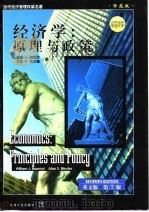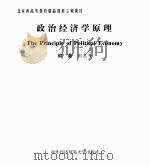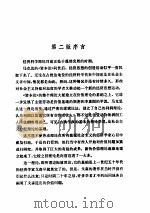《经济学:原理与政策》
| 作者 | 威廉J.鲍默尔 艾伦S.布兰德 编者 |
|---|---|
| 出版 | 北京市:机械工业出版社 |
| 参考页数 | 947 |
| 出版时间 | 1998.06(求助前请核对) 目录预览 |
| ISBN号 | 7111064747 — 求助条款 |
| PDF编号 | 86579128(仅供预览,未存储实际文件) |
| 求助格式 | 扫描PDF(若分多册发行,每次仅能受理1册) |

PART I1
GETTING ACQUAINTED WITH ECONOMICS1
1 What Is Economics?3
2 The U.S. Economy: Myth and Reality25
3 Scarcity and Choice: The Economic Problem49
4 Supply and Demand: An Initial Look67
PART II93
ESSENTIALS OFMICROECONOMICS:CONSUMERS AND FIRMS93
5 Consumer Choice: The Demand Side of the Market95
6 Demand and Elasticity125
7 Production, Inputs, and Cost: Building Blocks for Supply Analysis147
8 Output, Price, and Profit:The Importance of Marginal Analysis181
PART III207
THE MARKET SYSTEM: VIRTUES AND VICES207
9 The Firm and the Industry under Perfect Competition209
10 The Price System and the Case for Laissez-Faire233
11 Monopoly255
12 Between Competition and Monopoly275
13 The Market Mechanism: Shortcomings and Remedies301
14 Real Firms and Their Financing: Stocks and Bonds325
PART IV349
THE DISTRIBUTION OF INCOME349
15 Pricing the Factors of Production351
16 Labor: The Human Input377
17 Poverty, Inequality, and Discrimination403
PART V429
THE GOVERNMENT AND THE ECONOMY429
18 Limiting Market Power: Regulation of Industry431
19 Limiting Market Power: Antitrust Policy451
20 Taxation and Resource Allocation469
21 Environmental Protection and Resource Conservation: The Economist's Approach491
PART VI515
THE MACROECONOMY:AGGRSGATE SUPPLY AND OEMAND515
22 The Realm of Macroeconomics517
23 Unemployment and Inflation: The Twin Evils of Macroeconomics537
24 Income and Spending: The Powerful Consumer563
25 Demand-Side Equilibrium: Unemployment or Inflation?587
26 Changes on the Demand Side: Multiplier Analysis609
27 Supply-Side Equilibrium: Unemployment and Inflation?627
PART VII647
FISCAL AND MONETARY POLICY647
28 Managing Aggregate Demand: Fiscal Policy649
29 Money and the Banking System671
30 Monetary Policy and the National Economy695
31 The Debate over Monetary Policy717
32 Budget Deficits and the National Debt: Fact and Fiction745
33 The Trade-off between Inflation and Unemployment769
PART VIII795
THE UNITED STAES IN THE WORLD ECONOMY795
34 International Trade and Comparative Advantage797
35 The International Monetary System: Order or Disorder?821
36 Macroeconomics in a World Economy845
37 Productivity and Growth in the Wealth of Nations865
38 Comparative Economic Systems: What Are the Choices?897
ACQUAINTED WITH ECONOMICS1
CHAPTER 1 WHAT IS ECONOMICS?3
Ideas for Beyond the Final Exam3
Idea 1: Mutual Gains from Voluntary Exchange4
Idea 2: Rational Choice and True Economic Costs: The Role of Opportunity Cost4
Idea 3: Attempts to Repeal the Laws of Supply and Demand: The Market Strikes Back5
Idea 4: The Importance of Marginal Analysis5
Idea 5: Externalities: A Shortcoming of the Market Cured by Market Methods6
Idea 6: The Cost Disease of the Personal Services6
Idea 7: The Trade-off between Output and Equality7
Idea 8: The Trade-off between Inflation and Unemployment7
Idea 9: The Illusion of High Interest Rates8
Idea 10: Do Budget Deficits Burden Future Generations?8
Idea 11: The Overwhelming Importance of Productivity Growth in the Long Run9
Idea I2: The Surprising Principle of Comparative Advantage9
Inside the Economist's Tool Kit10
Economics as a Discipline10
The Need for Abstraction10
The Role of Economic Theory13
What Is an Economic "Model"15
Reasons for Disagreements: Imperfect Information and Value Judgments16
Last World: Common Sense Is Not Always Reliable17
Summary17
Key Terms17
Questions for Review18
Appendix: The Graphs Used in Economic Analysis18
Two-Variable Diagrams18
The Definition and Measurement of Slope19
Rays through the Origin and 45? Lines22
Squeezing Three Dimensions into Two: Contour Maps23
Summary24
Key Terms24
Questions for Review24
CHAPTER 2 The U.S. Economy: MYTH AND REAUTY25
The American Economy:A Thumbnail Sketch25
A Growing Economy...but with Inflation28
The Inputs:Labor and Capital32
The Outputs:What America Produce?34
Public Opinion on Profits35
The Central Role of Business Firms35
Is That an American Company?36
What's Missing from the picture Government36
Conclusion:The Mixed Economy40
Summary41
Key Terms41
Questions for Review41
Appendix:Further Perils in the Interpretation of Graphs42
Distorting Trends by Choice of the Time Period42
Dangers of Omitting the Origin43
Unreliability of Steepness and Choice of Units44
Summary47
Questions for Review47
CHAPTER 3 SCARCITY AND CHOICE: THE ECONOMIC PROBLEM49
Problem:The"indispensable Necessity"Syndrome50
Scarcity,Choice,and Opportunity cost50
Scarcity and Choice for a Single Firm52
The Principle of Increasing Costs54
Scarcity and Choice for the Entire Society55
A Military-Civilian Output Trade-off in Reality55
Scarcity and Choice Elsewhere the Economy57
The Concept of Efficiency59
The Three Coordination Tasks of Any Economy60
Specialization,Division of Labor,and Exchange60
Adam Smith (1723--1790)61
Markets,prices,and the Three Coordination Tasks62
Liberal and Conservative Goals Can Both Be Served by the Market Mechanism63
Summary64
Key Terms65
Questions for Review65
CHAPTER 4SUPPLY AND DEMAND:AN INITIAL LOOK67
Fighting the Invisible Hand68
Price COntrols at Valley Forge68
Demand and the Quantity Demanded69
Supply and the Quantity Supplied71
Equilibrium of Supply and Demand73
Shifts of the Demand Curve75
Shifts of the Supply Curve79
Restraining the Market Mechanism:Price Ceilings83
Policy Debate: Economic Aspects of the War on Drugs84
Restraining the Market Mechanism:Price Floors86
A Can of Worms87
A Simple but Powerful Lesson89
Summary89
Key Terms90
Questions for Review90
PART IIESSENTIALS OF MICROECONOMICS:CONSUMERS AND FIRMS93
CHAPTER 5 CONSUMER CHOICE: THE DEMAND SIDE OF THE MARKET95
A Paradox: Should Water Be Worth More Than Diamonds?96
Scarcity and Demand96
Total ond Marginal Utility97
Do Consumers Really Behave "Rationally" and Maximize Utility?101
From Marginal Utility to the Demand Curve103
Consumer Choice as a Trade-off Opportunity Cost104
Consumer Surplus: The Net Gain from a Purchase105
Resolving the Diamond-Water Paradox107
Price, Income, and Quantity Demanded107
From Individual Demand Curves to Market Demand Curves110
The "Law" of Demand111
Summary112
Key Terms113
Questions for Review113
Appendix: Indifference Curve Analysis114
Geometry of Available Choices: The Budget Line114
What the Consumer Prefers: The Indifference Curve116
The Slopes of Indifference Curves and Budget Lines118
The Consumer's Choice119
Consequences of Income Changes: Inferior Goods121
Consequences of Price Changes: Deriving the Demand Curve121
Summary123
Key Terms123
Questions for Review124
CHAPTER 6 DEMAND AND ELASTICITY125
Two Illustrative Cases125
Example I: The Revenue Effect of a Sales-Tax Cut125
Example II: Polaroid v.Kodak126
Elasticity: The Measure of Responsiveness127
Price Elasticity of Demand and the Shapes of Demand Curves130
The Relationship between Elasticity.ond Slope132
Price Elasticity of Demand and Total Expenditure133
What Determines Elasticity of Demand?135
Price Elasticity:Ignore It at Your Peril136
Elasticity as a General Concept137
Cross Elasticify of Demand: Substitutes and Complements137
How Large Is a Firm's Market share? Cross Elasticity as a Test139
Shifts of the Demand Curve: Advertising, Income, and the Prices of Complements and Substitutes139
The Time Dimension of the Demand Curve and Economic Decision Making141
Two Illustrative Applications of Elasticity Analysis142
Summary143
Key Terms143
Questions for Review143
Appendix: Statistical Analysis of Demand Relationships144
An Illustration: Did the Advertising Program Work?146
CHAPTER 7 PRODUCTION, INPUTS, AND COST BUILDING BLOCKS FOR SUPPLY ANALYSIS147
Application: Are Larger Firms More Efficient?148
Production, Input Choice, and Cost with One Variable Input149
The "law" of Diminishing Marginal Returns151
The Optimal Quantity of an Input and Diminishing Returns152
cost Curves and Input Quantities153
Fixed Costs and Variable Costs156
Long-Run versus Short-Run Costs159
The Average Cost Curve in the Short and Long Run160
Multiple Input Decisions:The Choice of Optimal Input Substitutability: The Choice of Input Proportions162
The Marginal Rule for Optimal Input Proportions164
The Production Function and the Firm's Cost Curves165
Input Substitution in the Forest165
Economies of Stale167
Policy Debate: Should Water Be Provided to Western Farmers at Subsidized Prices?167
The "law" of Diminishing Marginal Returns and Returns to Scale169
Historical Costs versus Analytical Cost Curves170
Resolving the Economies of Stale Puzzle170
Cost Minimization in Theory and Practice172
Summary173
Key Terms173
Questions for Review174
Appendix: Production Indifference Curves174
Characteristics of the Production Indifference Curves175
The Choice of Input Combinations176
Cost Minimization, Expansion Path, and Cost Curves177
Effects of Changes in Input Prices178
Summary179
Key Terms179
Questions for Review179
CHAPTER 8 OUTPUT, PRICE, AND PROFIT: THE IMPORTANCE OF MARGINAL ANALYSIS181
Two Illustrative Cases182
Case 1: Making Profits by Selling Below Costs182
Case 2: Pricing a Six-Pack182
Price and Quantity: One Decision, Not Two182
Do Firms Really Maximize Profits?184
Total Profit: Keep Your Eye on the Goal185
Maximization of Total Profit189
Marginal Analysis and Maximization of Total Profit191
Marginal Revenue and Marginal Cost: Guides to an Optimum192
Polity Debate: Profit and the New Market Economies195
Generalization:The Logic of Marginal Analysis and Maximization196
Application: Fixed Cost and the Profit Maximization196
Marginal Analysis in Real Decision Problems198
Conclusion: The Fundamental Role of Marginal Analysis200
The Theory and Reality:A Word of Caution201
Summary202
Key Terms202
Questions for Review202
Appendix:The Relationships among Total,Average,and Marginal Data203
Graphical Representation of Marginal and Average Curves204
Questions for Review205
PART III207
THE MARKETSYSTEM: VIRTUES AND VICES207
CHAPTER 9 THE FIRM AND THE INDUSTRY UNDER PERFECT COMPETITION209
Two Practical Puzzles209
Issue 1: Pollution-Reduction Incentives That Increase Pollution210
Issue 2: Can Firms Shift the Burden of Taxation to Consumers210
Varieties of Market Structre: A Sneak Proview210
Perfect Competition Defined211
The Competitive Firm and Its Demand Curve212
Short-Run Equilibrium of the Perfectly Competitive Firm213
Short-Run Profit:graphic Representation215
The Case of Short-Term Losses215
Shutdown and Break-Even Analysis216
The Short-Run Supply Curve of the Competitive Firm218
The Short-Run Supply Curve of the Competitive Industry218
Industry Equilibrium in the Short Run220
Industry and Firm Equilibrium in the Long Run221
The Long-Run Industry Supply Curve224
Zero Economic Profit: The Opportunity Cost of Capital225
Perfect Competition and Economic Efficiency226
Policy Debate: Should Perfect Competition Be Used as a Guide by Government Regulators?227
Our Two Puzzles Resolved228
Summary230
Key Terms231
Questions for Review231
CHAPTER 10 THE PRICE SYSTEM AND THE CASE FOR LASSEZ-FAIRE233
Puzzle: San Francisco Bay Bridge Pricing234
Efficient Resource Allocation: The Concept234
Pricing to Promote Efficiency: An Example235
Earthquake, Bridge Congestion, and Route Substitution237
Con Price Increases Ever Serve the Public Interest?237
Scarcity and the Need to Coordinate Economic Decisions239
Economic Shock Therapy in Poland240
Three Coordination Tasks in the Economy240
Input-Output Analysis: The Near Impossibility of Perfect Central Planning243
Input-Output Equations: An Example245
How Perfect Competition Achieves Efficiency: What to Produce245
Other Roles of Prices: Income Distribution and Fairness248
San Francisco Bridge Pricing Revisited249
Toward Assessment of the Price Mechanism230
Another Look at the Market's Achievement:Growth versus Efficiency250
Policy Debate: User Charges for Public Facilities251
Summary252
Key Terms252
Questions for Review252
CHAPTER 11 MONOPOLY255
Application: Monopoly and Pollution Charges255
Monopoly Defined256
Causes of Monopoly: Barriers to Entry and Cosi Advantages257
Natural Monopoly258
The Monopolist's Supply Decision259
Determining the Profit -Maximizing Output261
Comparison of Monopoly and Perfect Competition263
Con Anything Good Be Said about Monopoly?265
Price Discrimination under Monopoly267
Monopoly ond the Shifting of Pollution Charges270
Summary272
Key Terms273
Questions for Review273
CHAPTER 12 BETWEEN COMPETITION AND MONOPOLY275
Some Puzzling Observations276
Monopolistic Competition276
Price and Output Determination under Monopolistic Competition218
The Excess Capacity Theorem and Resource Allocation280
Oligopoly281
A Shopping List283
OPEC Keeps the Ceiling on Oil Output285
Policy Debate: Acting on Recognized InterdePendence versus "Tacit Collusion"286
The Kinked Demand Curve Model288
The Game-Theory Approach290
Monopolistic Competition, Oligopoly, and Public Welfare294
Billion-Dollar APPlication: Game Theory and the FCC Auction295
A Glance Backward: Comparison of the Four Market Forms296
Summary297
Key Terms298
Questions for Review298
CHAPTER 13 THE MARKET MECHANISM: SHORTCOMINGS ANO REMEDIES301
Puzzle: Rising Health-Care Costs in Canada302
What Does the Market Do Poorly?302
Efficient Resource Allocation: A Review302
Externalities:Getting the Prices Wrong304
Provision of Public Goods309
Allocation of Resources between Present and Future311
Some Other Sources of Market Failure313
Asymmetric Information, Lemons, and Agents314
Market Failure and Government Failure315
The Politics of Economic Policy316
The Cost Disease of the Service Sector316
Evaluative Comments321
Epilogue:The Unforgiving Market, Its Gift of Abundance, and Its Dangerous Friends322
Summary323
Key Terms324
Questions for Review324
CHAPTER 14 REAL FIRMS AND THEIR FINANCING: STOCKS AND BONDS325
Puzzle: The Stock Market's Unpredictability325
Firms in the United States326
Proprietorships326
Partnerships327
Corporations328
Stocks and Bonds330
Financing Corporate Activity332
Corporate Choice between Stocks and Bonds333
Buying Stocks and Bonds334
Selecting a portfolio:Diversification334
Following a Portfolio's Performance335
Stock Exchanges and Their Functions337
You Are There: An Event on the Trading Floor of the New York Stock Exchange338
Regulation of the Stock Market338
Stock Exchanges and Corporate Capital Needs339
The Recent Surge in Takeover Battles340
The lssue of Speculation341
How to Lose a Billion Dollars in One Easy Step: The Derivatives Craze342
Stock Prices as Random Walks343
Football and Financial Forecasting344
Summary346
Key Terms346
Questions for Review347
PART IV349
THE DISTRIBUTION OF INCOME349
CHAPTER 15 PRICING THE FACTORS OF PRODUCTION351
The Principle of Marginal Productivity352
The Derived Demand Curve for an Input353
Investment, Capital, and Interest355
The Determination of Rent:Simple Version361
Japanese Land Prices363
The Rent of Land: Some Complications364
Generalization:What Determines Shoquille O'Neal's Salary?365
Rent Seeking366
Rent Controls:The Misplaced Analogy368
Issue:Are Profits Too High or Too Low?369
What Accounts for Profits?370
EntrepreneurshiP in Poland371
Criticisms of Marginal Productivity Theory372
Summary373
Key Terms374
Questions for Review374
Appendix: Discounting and Present Value315
Summary376
Key Terms376
Questions for Review376
CHAPTER l6 LABOR: THE HUMAN INPUT317
ISSUE: Lagging Wages and Growing Inequality311
Competitive Labor Markets378
The Supply of Labor319
The Demand for Labor and the Determination of Wages381
Why Wages Differ382
Ability and Earnings:The Rent Component of Wages383
Investment in Human Capital384
Education and Earnings:Dissenting Views385
The Effects of Minimum Wage Legislation387
Unions and collective Bargaining388
The Development of Unionism in America390
The Way It Was391
Union as Labor Monopolies392
Monopsony and Bilateral Monopoly395
Collective Bargaining and Strikes396
The 1994--1995 Baseball Strike397
Recent Developments in the u.s.Labor Market399
Summary401
Key Terms401
Questions for Review402
CHAPTER 17 POVERTY, INEQUALITY,AND DISCRIMINATION403
Issue:Welfare Reform and the Trade-off between Equality and Efficiency403
The Facts:Poverty404
The Poorest Place in America406
The Facts:Inequality407
Depicting Income Distributions:The Lorenz Curve409
Some Reasons for Unequal Incomes410
How Important Is the Bell Curve?411
The Facts: Discrimination412
The Economic Theory of DIscrimination413
Are Women Better Workers?415
The Optimal Amount of Inequality416
The Trade-off between Equality and Efficiency417
Policies to Combat Poverty419
The Negative Income421
The Personal Income Tax423
Death Duties and Other Taxes424
Policies to Combat Discrimination424
Has Affirmative Action Outlived Its Usefulness?425
Postscript on the Distribution of Income425
Summary426
Key Terms426
Questions for Review427
PART V429
THE GOVERNMENT AND THE ECONOMY429
CHAPTER 18 LIMITING MARKET POWER:REGULATION OF INDUSTAY431
puzzle: Industry Opposition to Deregulation431
Monopoly,Regulation,and Nationalization432
What Is Regulated?BY Whom?432
A Brief History of Regulation433
Why Regulation?434
Why Regulators Sometimes Raise Prices436
A Problem of Marginal-Cost Prices438
Economic Theory in an ICC Coal Rate Decision440
Regulation of Profit and Incentives for Efficiency441
Price Caps as Incentives for Efficiency442
Pricing of Access to "Bottleneck" Services443
The Privy Council Approves Parity-Principle Access Pricing444
Some Effects of Deregulation445
Consequences of Deregulation:General Comments446
A Word on Privatization447
Industry Opposition to Deregulation--The Puzzle Revisited449
Summary449
Key Terms450
Questions for Review450
CHAPTER 19 LIMITING MRKET POWER: ANTITRUST POLICY451
The Public Image of Business When the Antitrust Laws Were Born452
Can Antitrust Law Be Used to Prevent Competition?453
The Antitrust Laws454
Protection of Competition, Not Protection of Competitors456
Merger Policy458
You Are There:An Antitrust Trial459
Issues in Concentration of Industry460
Evidence on Concentration in Industry462
The Pros and Cons of Bigness463
Other Government Programs Related to Bigness465
Issues in Antitrust Policy465
Summary467
Key Terms468
Questions for Review468
CHAPTER 20 TAXATION AND RESOURCE ALLOCATION469
Issue: Should We Flatten the Income Tax?470
The Level and Types of Taxation470
The Payroll Tax and the Social Security System474
The State and Local Tax System475
The Concept of Equity in Taxation476
The Concept of Efficiency in Taxation478
Excess Burden and Mr.Figg480
Tax Loopholes and Excess Burden481
Shifting the Burden of Taxation: Tax Incidence481
The Incidence of Excise Taxes482
The Incidence of the Payroll Tax484
When Taxation Con Improve Efficiency485
Equity,Efficiency,and the Optimal Tax486
Conclusion:The Virtues and Vices of a Flat Tax486
Summary487
Key Terms488
Questions for Review488
CHAPTER 21 ENVIRONMENTAL PROTECTION AND RESOURCE CONSERVATION:THE ECONOMIST'S APPROACH491
Part 1: The Economics of Environmental Protection492
The Facts: Is Everything Really Getting Steadily Worse?491
The Law of Conservation of Matter and Energy495
Governments and Individuals as Damagers of the Environment496
Environmental Damage as an Externality496
Supply-Demand Analysis of Environmental Externalities497
Basic Approaches to Environmental Policy498
Emissions Taxes versus Direct Controls500
Other Financial Devices to Profect the Environment: Emissions Permits502
A Market Approach to Cutting Environmental Protectiotn Costs503
Two Cheers for the Market504
Part 2: The Economics of Energy and Natural Resources504
The Permanent Fuel Crisis505
The Free Market and Pricing of Depletable Resources505
Resource Prices in the 20th Century508
On the Virtues of Rising Prices511
Growing Reserves of Exhaustible Resources: Our Puzzle Revisited512
Summary512
Key Terms513
Questions for Review513
PART VI515
THE MACROECONOMY:AGGREGATE SUPPLY AND DEMAND515
CHAPTER 22 THE REALM MACROECONOMICS517
Drawing o Line between Macroeconomics and Microeconomics517
Supply and Demand in Macroeconomics519
Gross Domestic Product521
Limitations of the GDP: What GDP Is Not523
Are Americans Working More?525
The Economy on o Roller Coaster525
"Green" GDP526
Life in "Hooverville"529
From World War 11 to 1973529
John Maynard Keynes (1883--1946)530
The Great Stagflation,1973--1980531
Reaganomics and Its Aftermath531
Clintonomics: Deficit Reduction and the Resumption of Growth532
The Problem of Macroeconomic Stabilization:A Sneak Preview532
Summary535
Key Terms535
Questions for Review536
CHAPTER 23 UNEMPLOYMENT AND INFLATION: THE TWON EVILS OF MACROECONOMICS537
The Costs of Unemployment538
The Economic Costs of High Unemployment539
Counting the Unemployed: The official Statistics541
Types of Unemployment542
How Much Employment Is "Full Employment"?543
Policy Debate: Does the Minimum Wage Cause Unemployment?544
Unemployment Insurance: The Invaluable Cushion544
Unemployment Insurance and the Costs of Unemployment545
The Costs of Inflation546
Inflationt The Myth and the Reality546
Inflation as a Redistributor of Income and Wealth549
Real versus Nominal Interest Rates550
Inflation and the Tax System551
Interest Rate Ceilings and Other Impediments553
Other Costs of Inflation554
The Costs of Low versus High Inflation554
Hyperinflation and the Piggy Bank556
Summary557
Key Terms558
Questions for Review558
Appendix: How Statisticians Measure Inflation558
Index Numbers for Inflation558
The Consumer Price Index559
How to Use a Price Index to "Deflate" Monetary Figures560
The GDP Deflator560
Your Personal CPI561
Summary561
Key Terms562
Questions for Review562
CHAPTER 24 INCOME AND SPENDING: THE POWERFUL CONSUMER563
A Puzzle: Demand Management and the Ornery Consumer564
Case 1: The 1964 Tax Cut564
Case 2: The 1975 Tax Cut564
Case 3: The 1981--1984 Tax Cuts564
Aggregate Demand, Domestic Product, and National Income565
The Cirtular Flow of Spending, Production, and Income566
Consumer SPending and Income: The Important Relationship568
The Consumption Function and the Marginal Propensity to Consume571
Movements along versus Shifts of the Consumption Function573
Other Determinants of Consumer Spending574
Policy Debate: Using the Tax Code to Spur Saving576
Why Tax Policy Failed in 1975576
The Predictability of Consumer Behavior578
Summary578
Key Terms579
Questions for Review579
Appendix: National Income Accounting580
Defining GDP: Exceptions to the Rules580
GDP as the Sum of Final Goods and Services581
GDP as the Sum of All Factor Payments581
GDP as the Sum of Values Added584
Summary585
Key Terms586
Questions for Review586
CHAPTER 25DEMAND-SIDE EQUILIBRIUM: UNEMPLOYMENT OR INFLATION?587
Puzzle: Why Does the Market Permit Unemployment?588
The Extreme Variability of Investment588
The Investment Boom of the Nineties589
The Determinants of Net Exports591
The Meaning of Equilibrium GDP592
Equilibrium on the Demand Side of the Economy594
Constructing the Expenditure schedule594
The Mechanics of Income Determination596
The Aggregate Demand Curve598
Demand-side Equilibrium and Full Employment600
The Coordination of saving and Investment602
Unemployment and Inflation as Coordination Failures604
Summary605
Key Terms605
Questions for Review606
Appendix:The Simple Algebra of Income Determination607
Questions for Review607
CHAPTER 26CHANGES ON THE DEMAND SIDE:MULTIPLIER ANALYSIS609
Case Study: How Did Kansas Do It?609
The Magic of the Multiplier610
Demystifying the Multiplier:How it Works611
Algebraic Statement of the Multiplier614
We Multiplier Effect of Consumer Spending615
The Multiplier Effect of Government Purchase616
The Multiplier Effect of Net Exports617
The Multiplier in Reverse618
The Paradox of Thrift519
The Multiplier and the Aggregate Demand Curve619
Summary621
Key Terms621
Questions for Review621
Appendix A:The simple Algebra of the Multipler622
Appendix B:The Multiplier with Variable Imports622
Summary626
Questions for Review626
CHAPTER 27 SUPPLY-SIDE EQUILIBRIUM:UNEMPLOYMENT AND INFLATION?627
Debate:Two Sides to the Supply Side627
The Aggregate Supply Curve628
Shifts of the Aggregate Supply Curve630
Equilibrium of Aggregate Demand and Supply632
Recessionary and Inflationary Gaps Revisited633
Adjusting to a Recessionary Gap:Deflation or Unemployment?635
An Example from Recent History:Disinflation in the 1990s638
Adjusting to an inflationary Gap:Inflation638
Tight Labor Markets in 1995639
Demand Inflation and Stagflation640
Stagflation from Supply shifts641
Inflation and the Multiplier642
A Role for Stabilization policy645
Summary645
Key Terms645
Questions for Review646
PART VII647
FISCAL AND MONETARY POLICY647
CHAPTER 28MANAGING AGGREGA DEMAND:FISCAL POLICY AOOR.GALUCY649
Issue:How Quickly Should We Balance the Budget?649
Income Taxes and the Consumption Schedule650
The Multiplier Revisited654
Multipliers for Ta Policy655
Government Transfer Payments657
Planning Expansive Fiscal Policy657
Planning Restrictive Fiscal Policy658
The Choice between Spending Policy and Tax Policy659
Some Harsh Realities660
The Idea behind Supply-Side Tax Cuts661
Some Files in the Ointment663
Toward Assessment of Supply-Side Economics664
Clintonomics and Supply-Side Economics665
Summary665
Key Terms666
Questions for Review666
Appendix:Algebraic Treatment of Fiscal Policy and Aggregate Demand667
Questions for Review669
CHAPTER 29 MONEY AND THE BANKING SYSTEM671
Issue: To Regulate or to Deregulate?That is the Question671
Barter Versus Monetary Exchange672
The Conceptual Definition of Money674
What Serves as Money?674
How the Quantity of Money is Measured676
How Banking Began678
Is There a Smart Card in Your Future?679
Principles of Band Management:profits versus Safety680
Bank Regulation680
The Savings and Loan Crisis: Over at Last681
How Bankers Keep Books681
Policy Debate: Abolish the Community Reinvestment Act?682
The Limits to Money Creation by a Single Bank683
Multiple Money Creation by a Series of Banks685
The Process in Reverse:Multiple Contractions of the Money Supply688
Why the Deposit Creation Formula is Oversimplified690
The Need for Monetary Policy691
Summary691
Key Terms692
Questions for Review692
CHAPTER 30MONETARY POLICY AND THE NATIONAL ECONOMY695
Money and Income:The Important Difference695
The Federal Reserve System:Origins and Structure696
The Independence of the Fed691
You Are There: The FOMC Meets698
Policy Debate: How Independent Should the Central Bank Be?699
Controlling the Money Supply: Open-Market Operations699
Open-Market Operations,Bond Prices,and Interest Rates701
Controlling the Money Supply:Lending to Banks702
Controlling the Money Supply:Reserve REquirements703
The Money Supply Mechanism704
The Demand for Money705
Equilibrium in the Money Market706
Interest Rates and Total Expenditures708
Monetary Policy and Aggregate Demand709
Money and the Price Level in the Keynesian Model711
From Models to Policy Debates713
Summary713
Key Terms714
Questions for Review714
CHAPTER 31 THE DEBATE OVER MONETARY POLICY717
Issue: Should We Forsake Stabilization Policy?717
Velocity and the Quantity Theory of Money718
The Determinants of Velocity720
Monetarism:The Quantity Theory Modernized722
Fiscal Policy, Interest Rates, and Velocity724
Debate:Should Stabilization Policy Rely on Fiscal or Monetary Policy?725
Debate:Should the Fed Control the Money Supply or control Interest Rates?727
Debate:The Shape of the Aggregate Supply Curve730
Debate:Should the Government Intervene?733
Debate:Rules or Discretion?736
Techniques of Economic Forecasting737
The Accuracy of Economic Forecasts739
Other Dimensions of the Rules-Versus-Discretion Debate739
Conclusion:What Should be Done?741
Summary742
Key Terms743
Questions for Review743
CHAPTER 32 BUDGET DEFICITS AND THE NATIONAL DEBT: FACT AND FICTION745
Puzzle:Are Smaller Deficits Good or Bad for Growth?746
Should the Budget Be Balanced?746
Deficits and Debt:Some Terminology747
Some Facts about the National Debt748
Interpreting the Budget Deficit750
Inflation Accounting for Interest Payments752
Bogus Arguments about the Burden of Burden of the Debt756
Budget Deficits and Inflation757
Deficits,INterest Rates, and Crowding Out761
POlicy Debate: A Balanced-Budget Amendment to the Constitution?762
The True Burden of the National Debt763
Deficit Reduction and Growth:Puzzle Resolved764
Conclusion:The Economics and Politics of the Budget Deficit765
America speaks: How to Reduce the Budget Deficit766
Summary767
Key Terms768
Questions for Review768
CHAPTER 33THE TRADE-OFF BETWEN INFLATION AND UNEMPLOYMENT769
Demand-Side Inflation Versus Supply-Side Inflation:A Review770
Applying the Model to a Growing Economy771
Demand-Side Inflation and the Phillips Curve773
Supply-Side Inflation and the Collapse of the Phillip Curve777
What the Phillips Curve is Not778
Fighting Unemployment with Fiscal and Monetary Policy781
What Should Be Done?782
Inflationary Expectations and the Phillips Curve783
The Theory of Rational Expectations786
Why Economists(and Politicians)Disagree788
The Dilemma of Demand Management789
Attempts to Reduce the Natural Rate of Unemployment789
Policy Debate:Should the Fed Concentrate Only on Reducing Inflation?790
Wage-Price Controls190
Indexing191
Summary792
Key Terms793
Questions for Review793
PART VIII795
THE UNITED STAES IN THE WORLO ECONOMY795
CHAPTER 34INTERNATIONAL AND COMPARATIVE ADVANTAGE797
Puzzle: How Can Americans Compete with"Cheap Foreign Labor"?797
Why Trade?798
Mutual Gains from Trade799
International Versus Intranational Trade800
The Law of Comparative Advantage801
David Ricardo(1772--1823)802
The Arithmetic of Comparative Advantage802
The Graphics of Comparative Advantage803
Comparative Advantage and Competition of "Cheap Foreign Labor"806
Supply-Demand Equilibrium and Pricing in World Trade807
Tariffs, Quotas, and other Interferences with Trade808
How Tariffs and Quotas Work809
How Sweet It Is:The U.S.Sugar Quota810
Tariffs versus Quotas811
Why Inhibit Trade?812
Other Arguments for Protection814
Can Protectionism save Free Trade?816
Con Cheap Imports Be Bad for a Country817
Conclusion:A Last Look at the "Cheap Foreign Labor"Argument817
Unfair Foreign Competition818
Summary818
Key Terms819
Questions for Review819
CHAPTER 35 THE INTERNATIONAL MONTARY SYSTEM:ORDER OR DISORDER?821
Puzzle: Whatever Happened to Mexico?821
What Are Exchange Rates?822
Exchange Rate Determination in a Free Market823
The Purchasing-Power Parity Theory:The Long Rum826
Economic Activity and Exchange Rates:The Medium Rum827
Purchasing-Power Parity and the Big Mac828
Interest Rates and Exchange Rates:The Short Run829
Market Determination of Exchange Rates:Summary830
Fixed Exchange Rates and the Balance of Payments830
Defining the Balance of Payments in Practice833
A Bit of History:The Gold Standard834
The Bretton Woods System and the International Monetary Fund835
Adiustment Mechanisms under Fixed Exchange Rates836
Why Try to Fix Exchange Rates?838
The Current Mixed System839
The volatile Dollar839
The European Exchang Rate Mechanism841
Summary842
Key Terms842
Questions for Review843
CHAPTER 36MACROECONOMICS IN A WORLD ECONOMY845
Issue:Deficit Reduction and the Dollar845
International Trade and Aggregate Demand:A Quick Review846
Relative Prices,Exports,and Imports847
The Effects of Changes in Exchange Rates847
Aggregate Supply in an Open Economy849
The Macroeconomic Effects of Exchange Rates850
Interest Rates and International Capital Flows851
Fiscal Policy in an Open Economy852
Monetary Policy in an Open Economy854
International Aspects of Deficit Deficit Reduction855
The Link Between the Budget Deficit and the trade Deficit857
Is the Trade Deficit a Problem?858
On Curing the Trade Deficit862
Summary862
Key Terms863
Questions for Review863
CHAPTER 31 PRODUCTIVITY AND GROWTH IN THE WEALTH OF NATIONS865
Part 1: Growth in the United States and Other Industrial Countries865
Life in the "Good Old Days"865
The Magnitude of Productivity Growth867
The Second Major Development:Convergence871
The U.S. Productivity Slowdown:Is American Economic Leadership Doomed?873
Productivity and the Deindustrialization Thesis875
Unemployment and Productivity Growth877
The Real Costs of Lagging Productivity:Lagging Wages and Living Standards878
Requirements for Increased Growth879
Growth without Sacrificing Consumption:Something for Nothing?880
On Growth in population:Is Less Realty More?880
Is More Growth Really Better?883
Part 2: Problems of the Less Developed Countries884
Recent Trends886
Impediments to Development in the LDC:887
Help from Industrialized Economies891
Con LDC: Break Away from Poverty?893
Summary893
Key Terms894
Questions for Review895
CHAPTER 38 COMPARATIVE ECONOMIC SYSTEMS: WHAT ARE THE CHOICES?897
Economic Systems:Two Important Distinctions898
The Market or the Plan?Some Issues899
The Market or the Plan:The Scoreboard900
Capitalism of Socialism?901
Socialism,Planning,and Freedom902
The Administrative Command Economy:The Old Soviet Union903
Economies in Transition: Russia and Her Neighbors905
A Tale of Two Countries907
China under Mao: Revolutionary Communism908
China since Mao: Explosive Growth909
Japan's Unique Brand of Capitalism910
U.S.-Japanese Trade: Is Everyone Playing Fair?911
Is Japan a Planned Economy?912
Can America Import Japanese Manufacturing Methods?913
What Can the United States born from (and Teach)Japan?913
Summary914
Key Terms915
Questions for Review915
1998.06《经济学:原理与政策》由于是年代较久的资料都绝版了,几乎不可能购买到实物。如果大家为了学习确实需要,可向博主求助其电子版PDF文件(由威廉J.鲍默尔 艾伦S.布兰德 1998.06 北京市:机械工业出版社 出版的版本) 。对合法合规的求助,我会当即受理并将下载地址发送给你。
高度相关资料
-

- 经济政策:原理与设计
- 1988 北京:商务印书馆
-

- 政治经济学原理
- 北京:对外经济贸易大学出版社
-

- 经济学原理与政策 第9版 下
- 北京市:北京大学出版社
-

- 经济学 原理与政策 第7版
- 1999 沈阳:辽宁教育出版社
-

- 政治经济学原理
- 1993 开封:河南大学出版社
-

- 农业经济学-原理和政策
- 1988 北京:农业出版社
-

- 政治经济学原理
- 1981 南宁:广西人民出版社
-

- 农业经济学 理论与政策
- 1993 哈尔滨:黑龙江人民出版社
-

- 政治经济学原理
- 1995 兰州市:兰州大学出版社
-

- 经济学 原理与政策 英文版·第7版
- 1998 北京:机械工业出版社
-

- 现代经济政策学原理
- 1994 海口:南海出版公司
-

- 政治经济学原理
- 1993 成都:成都科技大学出版社
-

- 未来-儿童文学专辑 第9辑
- 1984 南京:江苏人民出版社
-

- 政治经济学原理
- 1989 北京:经济科学出版社
提示:百度云已更名为百度网盘(百度盘),天翼云盘、微盘下载地址……暂未提供。➥ PDF文字可复制化或转WORD
